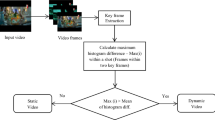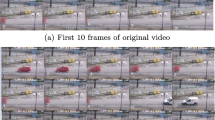Abstract
In the recent past, video forgery has increased rapidly due to the easy availability of the required tools to accomplish that. Temporal copy-move or frame duplication is one of the most common video forgery methods in which a set of consecutive frames is copied somewhere in the same video. This work proposes an ensemble based method to detect duplicate frames from a video. In this method, first, the frames are pre-processed and then three different kinds of features - Haralick, custom Haralick and Local Binary Pattern (LBP) are extracted from each frame of a video. Next, lexicographical sorting is performed to arrange the frames having similar feature values consecutively. A filter method is applied to eliminate the false detection and it also creates a duplicate sequence for each category. In the end, a voting mechanism is employed to predict the duplicate frames, if they exist. The proposed method performs very well (detection accuracy is 99.32%, the true positive rate is 99.79%, and the true negative rate is 99.19%) over an in-house dataset containing 300 videos of seven different types. The robustness of the proposed method has also been tested by adding various postprocessing to the video samples. The proposed method outperforms many state-of-the-art methods used here for comparison.











Similar content being viewed by others
References
Bakas J, Naskar R (2018) A digital forensic technique for inter–frame video forgery detection based on 3D CNN. In: International Conference on Information Systems Security, pp. 304–317. https://doi.org/10.1007/978-3-030-05171-6_16
Bakas J, Naskar R, Dixit R (2019) Detection and localization of inter-frame video forgeries based on inconsistency in correlation distribution between Haralick coded frames. Multimed Tools Appl 78(4):4905–4935. https://doi.org/10.1007/s11042-018-6570-8
Bharati MH, Liu JJ, MacGregor JF (2004) Image texture analysis: methods and comparisons. Chemom Intell Lab Syst 72(1):57–71. https://doi.org/10.1016/j.chemolab.2004.02.005
Chen H, Chen Z, Zeng X, Fan W, Xiong Z (2008) A novel reversible semi-fragile watermarking algorithm of MPEG-4 video for content authentication. In 2008 Second international symposium on intelligent information technology application, vol. 3, pp. 37–41
Chen S, Tan S, Li B, Huang J (2015) Automatic detection of object-based forgery in advanced video. IEEE Trans Circuits Syst Video Technol 26(11):2138–2151
D’Amiano L, Cozzolino D, Poggi G, Verdoliva L (2019) A PatchMatch-based dense-field algorithm for video copy-move detection and localization. IEEE Trans Circuits Syst Video Technol 29(3):669–682. https://doi.org/10.1109/TCSVT.2018.2804768
Fadl S, Megahed A, Han Q, Qiong L (2020) Frame duplication and shuffling forgery detection technique in surveillance videos based on temporal average and gray level co-occurrence matrix. Multimed Tools Appl 79:17619–17643
Fadl S, Han Q, Qiong L (2020) Exposing video inter-frame forgery via histogram of oriented gradients and motion energy image. Multidim Syst Sign Process 31:1–20
Fadl S, Han Q, Li Q (2021) CNN spatiotemporal features and fusion for surveillance video forgery detection. Signal Process Image Commun 90:116066. https://doi.org/10.1016/j.image.2020.116066
Farooq S, Yousaf MH, Hussain F (2017) A generic passive image forgery detection scheme using local binary pattern with rich models. Comput Electr Eng 62:459–472
Haralick RM, Dinstein I, Shanmugam K (1973) Textural features for image classification. IEEE Trans Syst Man Cybern 6:610–621. https://doi.org/10.1109/TSMC.1973.4309314
Hu Y, Zhao C (2010) A novel LBP based methods for pavement crack detection. J Pattern Recognit Res 5(1):140–147
Jia S, Xu Z, Wang H, Feng C, Wang T (2018) Coarse-to-fine copy-move forgery detection for video forensics. IEEE Access 6:25323–25335
Kharat J, Chougule S (2020) A passive blind forgery detection technique to identify frame duplication attack. Multimed Tools Appl 79:1–17
Li Q, Wang R, Xu D (2018) An inter-frame forgery detection algorithm for surveillance video. Information 9(12):301. https://doi.org/10.3390/info9120301
Long C, Basharat A, Hoogs A (2018) A coarse-to-fine deep convolutional neural network framework for frame duplication detection and localization in forged videos. In: 2019 IEEE/CVF Conference on Computer Vision and Pattern Recognition (CVPR) Workshops, pp 1–10
Malegori C, Franzetti L, Guidetti R, Casiraghi E, Rossi R (2016) GLCM, an image analysis technique for early detection of biofilm. J Food Eng 185:48–55
Mohiuddin S, Malakar S, Sarkar R (2021) Duplicate frame detection in forged videos using sequence matching. In: Proceedings - 3rd International Conference on Computational Intelligence in Communications and Business Analytics (CICBA-2021), pp. 1–11
Mohiuddin S, Ganguly S, Malakar S, Kaplun D, Sarkar R (2022) A feature fusion based deep learning model for deepfake video detection. In: International Conference on Mathematics and its Applications in new Computer Systems, pp. 197–206
Nguyen XH, Hu Y, Amin MA, Hayat KG (2020) Detecting video inter-frame forgeries based on convolutional neural network model. Int J Image Graph Signal Process 10(3):1. https://doi.org/10.5815/ijigsp.2020.03.01
Ojala T, Pietikäinen M, Harwood D (1996) A comparative study of texture measures with classification based on featured distributions. Pattern Recogn 29(1):51–59
Ojala T, Pietikäinen M, Mäenpää T (2002) Multiresolution gray-scale and rotation invariant texture classification with local binary patterns. IEEE Trans Pattern Anal Mach Intell 24(7):971–987. https://doi.org/10.1109/TPAMI.2002.1017623
Park JY, Lim JH, Kim GS, Won CS (2002) Invertible semi-fragile watermarking algorithm distinguishing MPEG-2 compression from malicious manipulation. In: 2002 Digest of Technical Papers. International Conference on Consumer Electronics (IEEE Cat. No. 02CH37300), pp. 18–19
Singh G, Singh K (2019) Video frame and region duplication forgery detection based on correlation coefficient and coefficient of variation. Multimed Tools Appl 78(9):11527–11562. https://doi.org/10.1007/s11042-018-6585-1
Singh VK, Pant P, Tripathi RC (2015) Detection of frame duplication type of forgery in digital video using sub-block based features, pp 29–38. https://doi.org/10.1007/978-3-319-25512-5
Sun D, Roth S, Lewis JP, Black MJ (2008) Learning optical flow. In: Proceedings of 10th European Conference on Computer Vision (ECCV), Part-III, pp 83–97
Yang J, Huang T, Su L (2014) Using similarity analysis to detect frame duplication forgery in videos. Multimed Tools Appl 75(2):1793–1811
Zhao D-N, Wang R-K, Lu Z-M (2018) Inter-frame passive-blind forgery detection for video shot based on similarity analysis. Multimed Tools Appl 77(19):25389–25408
Zheng L, Sun T, Shi Y-Q (2014) Inter-frame video forgery detection based on block-wise brightness variance descriptor. In: International Workshop on Digital Watermarking, pp. 18–30
Author information
Authors and Affiliations
Corresponding author
Ethics declarations
Conflict of interest
All the authors declare that they have no conflict of interest.
Additional information
Publisher’s note
Springer Nature remains neutral with regard to jurisdictional claims in published maps and institutional affiliations.
Rights and permissions
Springer Nature or its licensor (e.g. a society or other partner) holds exclusive rights to this article under a publishing agreement with the author(s) or other rightsholder(s); author self-archiving of the accepted manuscript version of this article is solely governed by the terms of such publishing agreement and applicable law.
About this article
Cite this article
Mohiuddin, S., Malakar, S. & Sarkar, R. An ensemble approach to detect copy-move forgery in videos. Multimed Tools Appl 82, 24269–24288 (2023). https://doi.org/10.1007/s11042-023-14554-3
Received:
Revised:
Accepted:
Published:
Issue Date:
DOI: https://doi.org/10.1007/s11042-023-14554-3




